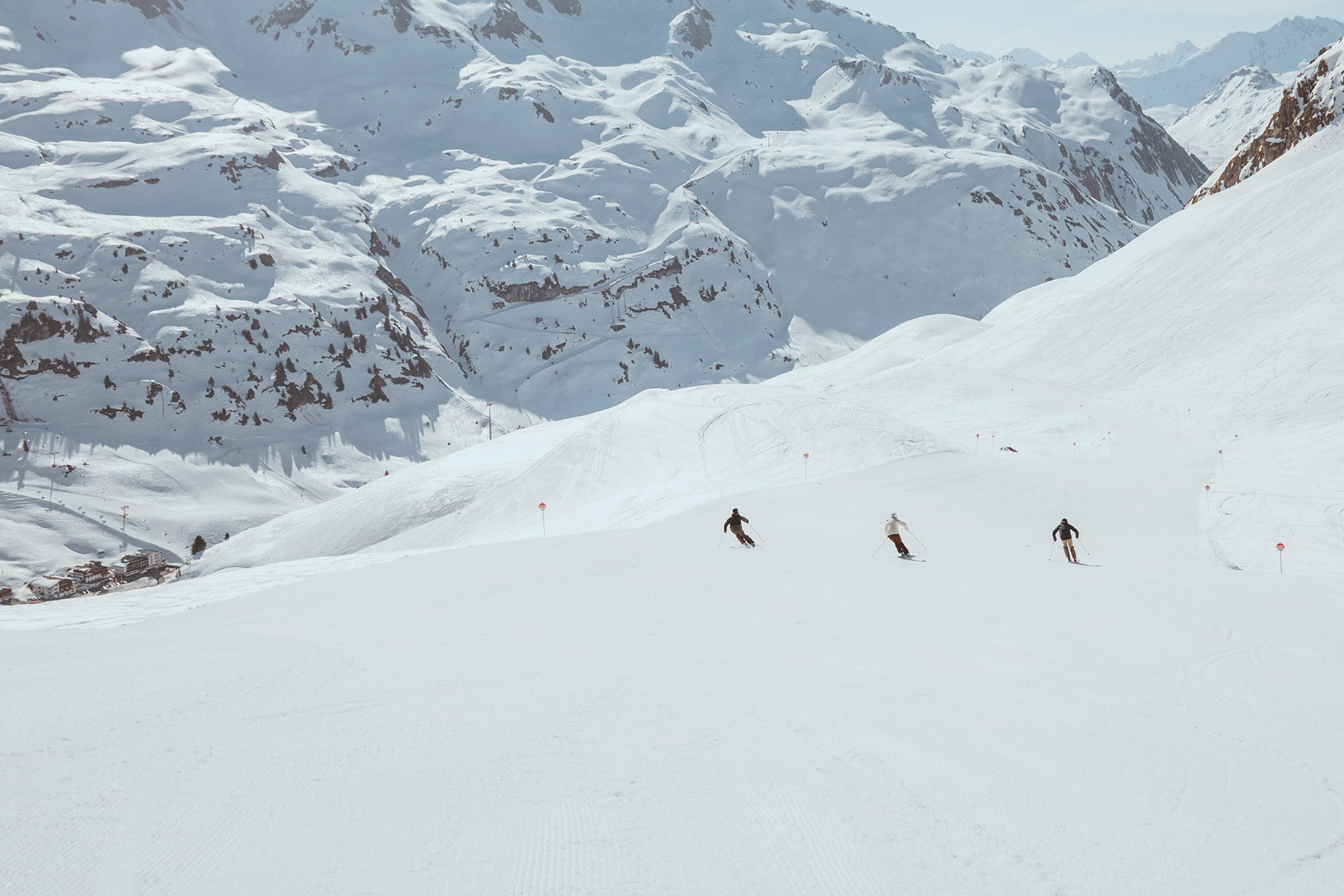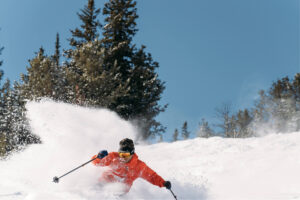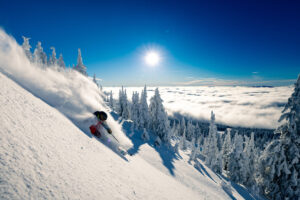A ski trip to Europe is the trip of a lifetime, since Europe is home to many of the world’s largest and best destination ski resorts. All told there are more than 1,000 ski areas in Europe. However, with so many amazing destinations and ski resorts to choose from in Europe, it can be hard narrowing it down when you may have just a few days. So let us help with our guide to the best ski destinations in Europe.
While this is by no means an exhaustive guide of where to go skiing in Europe, it’ll give you a little taste of what Europe’s best countries for skiing have to offer. What’s more, many of the best ski areas in Europe are close neighbors, forming huge, interconnected resorts—connected by trails, lifts, and shuttles—that offer endless variety. So without any further ado, let’s get into our guide to the best countries for skiing in Europe.
The Best Ski Destinations In Europe
France
Skiing in France usually means two things: Skiing at a very high altitude and skiing at huge, often cosmopolitan, ski resorts. A lot of France ski resorts, like La Plagne for instance, were built from scratch in the development boom of the 1950s and 1960s in parts of the Alps where there’d been little more than livestock grazing. And many of France’s ski resorts are located higher than any other European country. For example, Val Thorens is at 2,300 meters/7,500 feet, while Tignes is at 2,100 meters/6,900 feet. This means excellent snow conditions for late-fall, all of winter, and early spring.

Among the many enormous French ski areas, the Three Valleys and Portes du Soleil (8 resorts in France and 4 resorts in Switzerland) are the biggest and among the best ski resorts in Europe. Portes du Soleil spans 6oo kilometers of slopes that are dispersed into 12 individual resorts in France and Switzerland. The Three Valleys, Les 3 Vallées, is the world’s biggest interconnected ski resort, with 600 kilometers of slopes across 3 valleys and the seven world-famous ski resorts of Courchevel, Val Thorens, Orelle, Brides-les-Bains, Saint-Martin-de-Belleville, Méribel, and Les Menuires. This is a great option, too, if you’re traveling with kids, as there are tons of ski school options at many of these resorts.
Many of France’s ski resort villages, among which Chamonix is by far the biggest and most cosmopolitan, are home to tons of restaurants, pubs, concert venues, clubs, spas, and shopping. However, there are some exceptions. Les Gets in Haute-Savoie is among the smaller resorts that have retained their traditional charm, with alpine architecture, family-run guesthouses, and delicious regional cuisine made by local families. A partnership of three French associations awards family-friendly resorts with the “Famille Plus” label. So if you’re looking for family-focused activities, daycare, and entertainment for your kids, then look for a “Famille Plus” resort. Examples include Châtel, Les Gets, Les Deux Alpes, and Val Thorens.
Check out Lodging options in France.
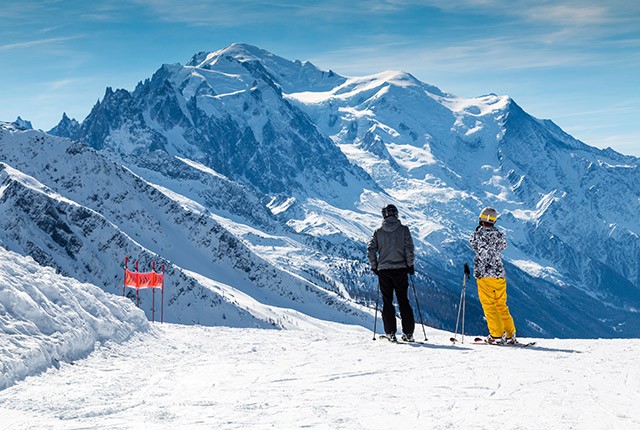
The airports in Geneva and Lyon provide the most international links to the Northern Alps. Nice Côte d’Azur Airport serves as the main international airport for the southern Alps, while the Milan and Turin airports are key for accessing the Southwestern and Western Alps. Buses and shuttle services run from each of these airports.
Austria
Austria, too, is home to some of the largest and best ski resorts in Europe. Its most popular ski region is Tyrol, with 3,400 kilometers of terrain and world-famous resorts such as Sölden, Ischgl, and St. Anton. The region of Salzburg is second in skiable terrain, with approximately 1,700 kilometers of slopes. Saalbach-Hinterglemm and Obertauern are Salzburg’s most popular ski resorts. Finally, there’s Vorarlberg, where Lech-Zuers am Arlberg is the area’s most popular resort, and the southern region of Carinthia. These areas boast approximately 1,000 kilometers of ski terrain.
Are you an Epic Pass holder? A number of the best ski resorts in Austria are now on the Epic Pass, including Sölden, Saalbach, Zell am See-Kaprun, Mayrhofen, Hintertux, and Silvretta Montafon.
Most Austrian ski resorts boast modern lift systems—like high-speed eight-person gondolas and heated chairlifts—and impeccably groomed, first-class slopes. Austria’s off-piste skiing is famous, especially in high-altitude areas such as the Arlberg, Silvretta-Montafon, and Grossglockner (Carinthia). The latter is Austria’s highest peak. Austria also attracts a lot of cross-country skiers thanks to thousands of kilometers of cross-country trails.

Austria’s lively après-ski scene begins at lunchtime. You can have beer, champagne, or Jagertee (tea with rum) in cozy huts close to the slopes or in bars and discotheques in the villages. St. Anton, Ischgl, Soelden, and Saalbach-Hinterglemm are famous for their après-ski parties. Austria is also home to alpine “Gemuetlichkeit” (geniality; friendliness) and delicious local cuisine. Most of the inns and huts are run by local families who are happy to serve you traditional dishes, such as dumplings, pasta, schnitzel and a variety of sweet pastries. Fruit schnapps (Obstler) afterward is a must-try. Visit when the World Cup racing season is in town for an extra treat (think Kitzbuehel and the Hahnenkamm Downhill in January). Note that Austria tends to be a bit less expensive than France in terms of food and drink.
Fly into Munich, or, even better, Innsbruck, which is an ideal base for Tyrol. You can reach many ski resorts from Innsbruck in anywhere from 15 minutes to a couple hours.
Check out Lodging options in Austria.
Switzerland
Switzerland is proud of its traditions, old heritage, and unique outdoor opportunities. Uniting several different cultures and languages in one country, Switzerland is also among the most diverse alpine winter sports destinations. Most of the Swiss ski resorts are located in the regions of Valais, Graubuenden, Central Switzerland, Bernese Oberland, and Eastern Switzerland. Valais offers the highest peaks (47 of them higher than 4,000 meters/13,000 feet) and the longest slopes (up to 17 kilometers, 10.5 miles, at Zermatt) in the region, while the Bernese Oberland is where you’ll find the coziest huts and the largest network of hiking and snowshoeing trails.
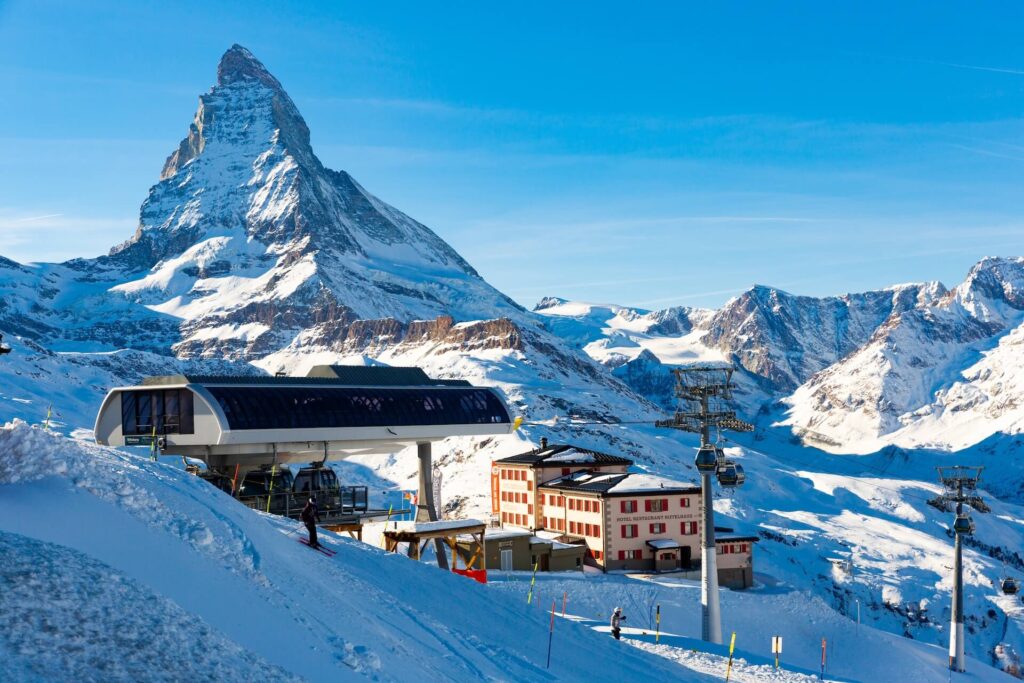
The Lake Geneva Region is famous for its nature reserves, but also for a number of incredible ski resorts, including one of Europe’s biggest ski destinations, Portes du Soleil (which as mentioned above included 4 Swiss resorts and 8 French resorts). Switzerland has a little bit of everything for skiers. In the Jungfrau Region, you can find powder slopes up to 2,970 meters (nearly 10,000 feet) high. While the Fribourg Region may not have the spectacular pistes as some of the others, it’s perfect for a budget ski vacation in Europe.
Check out Lodging options in Switzerland.
St. Moritz is arguably the sunniest, most glamorous ski resort in Switzerland. However, you’ll also be paying for it, since it’s consistently ranked as one of the world’s most expensive resorts. Smaller and less cosmopolitan ski resorts include Andermatt and Bruson, where a family of four can go skiing for a whole day and have a hearty Swiss lunch in a cozy hut for much less than the more famous Switzerland ski resorts. The most family-friendly ski resorts bear the “Familien Willkommen” (families welcome) label.

Zurich and Geneva are the most convenient Swiss airports for international skiers. Traveling from within Europe? Basel and Bern offer regional access. Alternatively, Switzerland’s railway system is among the world’s best—trains from 11 other countries arrive on a daily basis.
Italy
When you think skiing in Italy you may think South Tyrol. Located in the northernmost point of Italy, and formerly part of Austria, it’s known for stunning ski resorts, sprawling mountains, and cozy villages. Miles of groomed slopes and reliable snowmaking means that everyone will have plenty to play on. South Tyrol offers hearty cuisines (the ham and the Vinschgau bread are renowned) and exquisite wines to enjoy after the lifts stop spinning. Generally speaking, Italy can be more reasonably priced than other Europe ski destinations. For a uniquely Italian experience, stay at a farm home close to the ski resorts for a low-priced alternative to hotels.
The Dolomites (a UNESCO World Heritage site located mainly in the South Tyrol, Trentino, and Veneto regions) are regarded as the world’s most beautiful mountain range by many. The Dolomites reach all the way to northeastern Italy, to the Friuli-Venezia Giulia region neighboring Slovenia. The region features charming, internationally lesser-known resorts, such as Piancavallo and picturesque Valcellina, which are ideal for skiers who don’t need as much glamour.
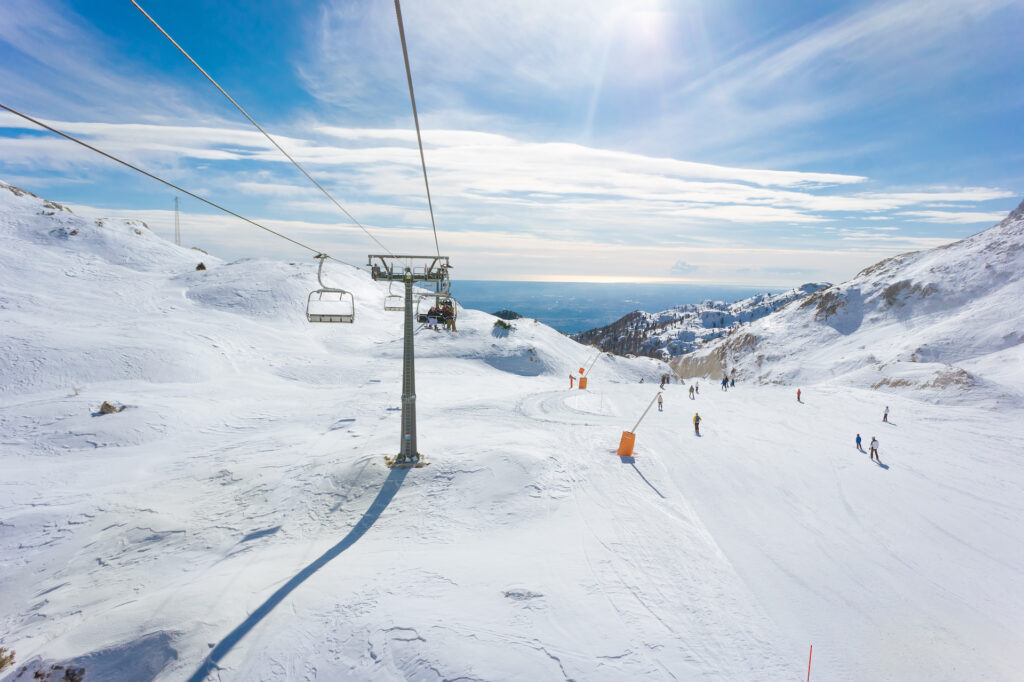
You may have also heard about Italy’s Dolomiti Superski resort alliance, the world’s largest ski resort alliance, spanning 12 resorts and 1,200 kilometers of slopes. Many of the ski resorts in the Dolomiti Superski resort alliance are quite demanding, catering to advanced skiers, especially in Trentino. Nevertheless, there’s a massive amount of terrain for beginner and intermediate skiers. If you want to ski multiple different ski resorts in Italy, then the Dolomiti Superski resorts are the way to go. Bonus: Dolomiti Superski is on the Ikon Pass. Those on the Ikon Pass get 7 days, while those on the Ikon Base Pass get 5 days (no blackouts).
Last, but not least, Veneto is Italy’s most popular region amongst tourists, where Dolomiti Superski’s Cortina d’Ampezzo is the best ski resort, home to nearly 120 kilometers (75 miles) of slopes. Don’t sleep on 3 Zinnen Dolomites, located just 45 minutes northeast of Cortina d’Ampezzo. What was once a destination of two small ski areas has grown extensively in the last decade into one large ski destination of five interconnected mountains with 115 km (71 miles) of runs.
Check out Lodging options in Dolomiti Superski.
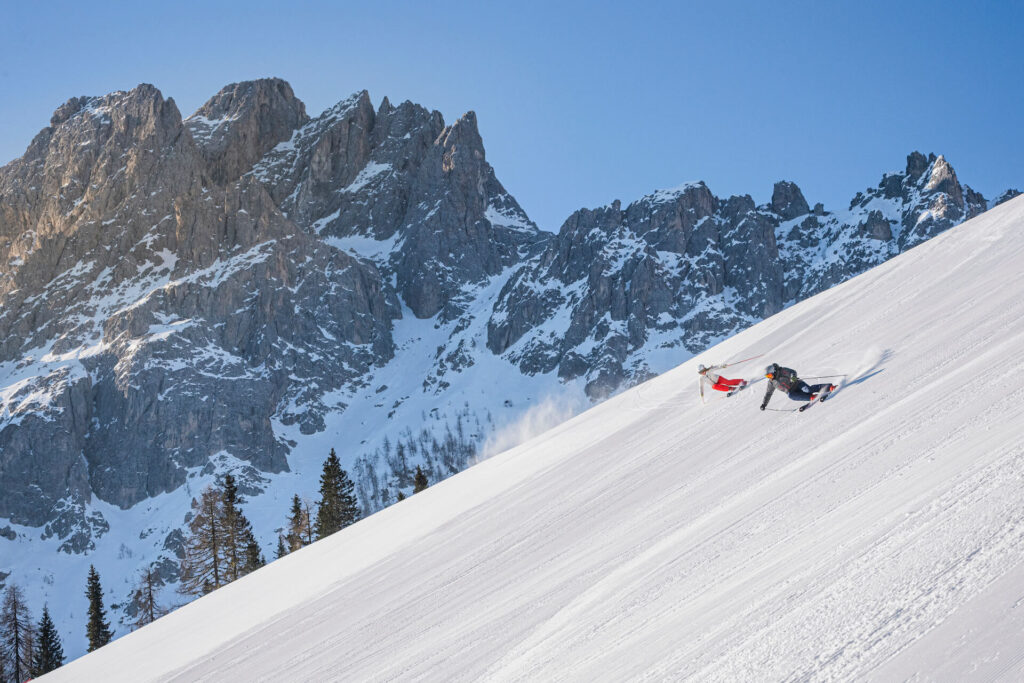
Europe’s Hidden Gem Ski Resorts
The newest trendy destination for skiing in Europe is Slovenia. Slovenia is budget-friendly, offers plenty of skiing, and boasts landscapes that look straight out of a fairy tale. Slovenia, located at the intersection of the Alps, Mediterranean, Pannonian Plain, and the Dynamic Alps, is about the best ski value you’ll find anywhere in Europe. The largest ski area in Slovenia is Mariborsko Pohorje, where there are plenty of trails, including one of the longest lit slopes in Europe for night skiing. Skiers and riders of all abilities will find plenty of terrain here.
Check out Lodging options in Slovenia.
Krvavec is close to Ljubljana, the capital of Slovenia, and offers a more casual affair, while Ski Centre Vogel in Triglav National Park features astounding views and will keep even the most die-hard skier happy. Slovenia’s oldest ski resort is Kranjska Gora, which opened in 1948. The ski resort is divided into five different sections around the municipality, and has a total of 12 miles of ski slopes and a terrain park for snowboarders. Kranjska Gora frequently hosts World Cup ski races.

Looking for another option? Try Andorra in the Pyrenees. Grandvalira is the largest ski area in the Pyrenees, home to 130 miles of ski terrain for all levels. Vallnord is smaller but ideal for families with a nice variety of slopes.
Check out Lodging options in Andorra.
Europe Ski Trip Tips
Depending on where you plan to ski in Switzerland, Austria, France or Italy, your gateway cities will likely be Geneva, Zurich, Munich, Innsbruck, or Milan, to name a few. Today, public transportation (trains and buses) is so efficient in Europe that you often don’t need a car. Plus, in many destinations you’ll find operators who offer ski transfers. Many ski villages are car-free as well, so once you arrive, everyone uses ski lifts and buses.
Finally, don’t forget to download our app (the North American version is here) to see snow reports, weather, snow cover, and more.
What Are The Best Ski Resorts In Europe?
This question of the best ski resorts in Europe is really subjective. It largely depends on what you’re looking for. Some of these ski resorts in Europe, like Tignes, Les Deux Alpes and Val d’Isère, attract advanced skiers. Yet Tignes, for example, is considered one of the best resorts for beginner skiers. If you want variety, then consider one of Europe’s sprawling interconnected ski areas. Many of these resorts offer more skiable terrain than you’ve ever seen. For a lively après-ski scene, St. Anton, Chamonix, Verbier, and Cervinia are among the great après-ski resorts in Europe.
Header: ©St. Anton am Arlberg

